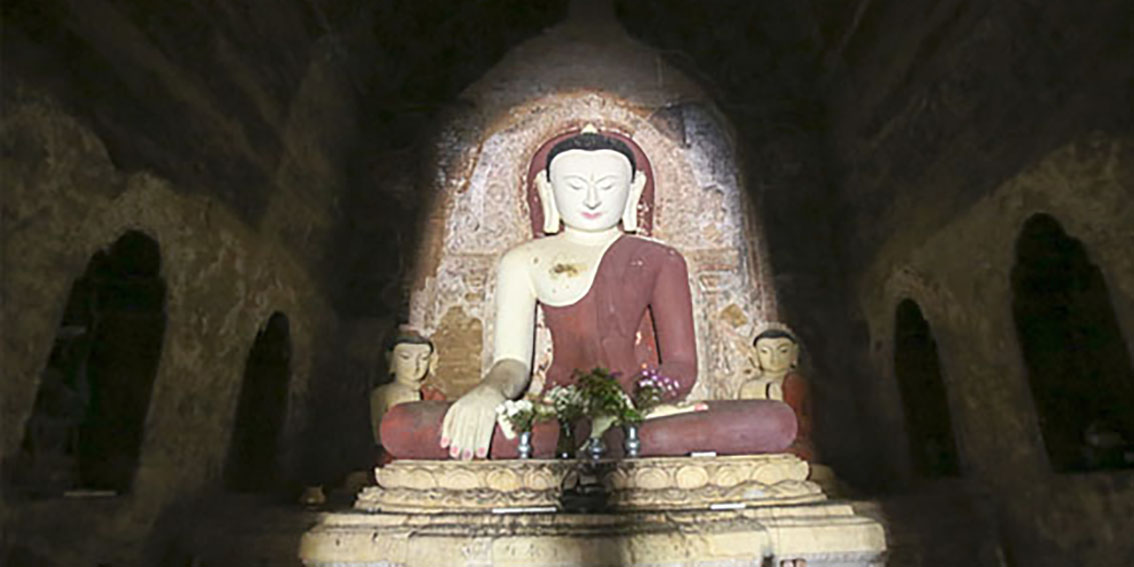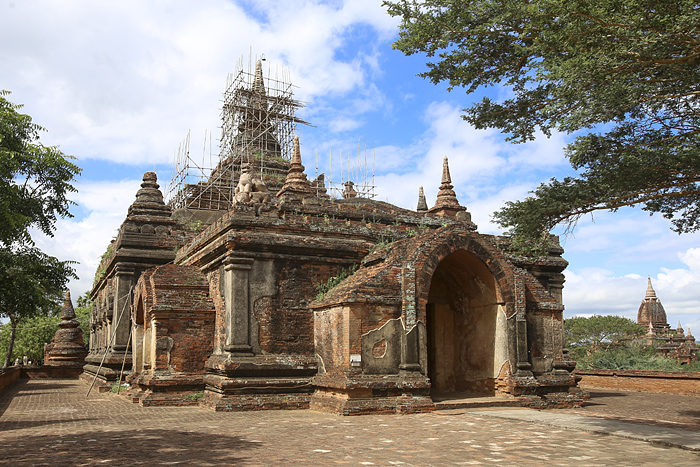
April 12, 2025
Abe-ya-dana-hpaya Temple, Bagan, Myanmar (late 11th century)
Designated Monument # 1202 by UNESCO.
Abe-ya-dana-hpaya is located immediately to the south of Myinkaba village, sitting on the north side of a group of temples that includes the Naga-yon-hpaya and the Som-min-gyi-hpaya stupa. The temple likely dates to the late 11th or early 12th centuries, though legends from the Glass Palace Chronicle (an 18th-19th century Konbaung era work) attribute it to Queen Apayatana, the consort of King Kyansittha (r. 1084-1112), who married the King prior to his coronation. Although there is no firm evidence tying the temple to Apayatana, the historian G. H. Luce did discover certain ink inscriptions on the entrance hall linking the temple to Apayatana, but concedes they were added long after the temple’s founding. Hence, the association with Apayatana must be taken with a certain grain of salt, though it does enliven the temple’s narrative.

In physical form, the temple is almost identical in plan to the nearby Naga-yon-hpaya, although it is slightly smaller and lacks the grand gateways and enclosure walls that extend the scale of the Naga-yon-hpaya. The heart of the temple comprises an inner chamber measuring 4.46 x 4.60 m containing three Buddhas, around which the enclosure wall (open to the north) contains niches on the inside and outside surfaces. Though once holding statues, most of these are now gone and the few that remain have largely been moved to the Bagan museum. The inner wall is in turn surrounded by an outer wall, creating a continuous barrel-vaulted corridor that runs around the inner core. This too is open on the north side, connecting it to a large vaulted antechamber (measuring 7.70 x 7.28m) that opens to the north (the principal direction) and to the east and west. The outside of the building is covered with highly decorated windows, three on each side except to the north. The tiered roof is surmounted by bell-shaped stupa and an octagonal spire comprised of various “umbrellas" giving it the shape of a cone, similar in form to the Pahto-hamya. Donald M. Stadtner notes that the shape of the stupa is similar to miniature stone stupas found in eastern India, which almost certainly provided served as models of most temple construction at Bagan.
The Abe-ya-dana-hpaya is justly famous for its mural paintings and other decorative motifs that push beyond the usual Theravada Buddhist themes employed at Bagan. For instance, the outer wall of the inner chamber is faced with niches that include seventeen separate roundels in between and above them, each depicting separate Hindu deities such as Brahma, Shiva, Vishnu, as well as lesser deities such as Agni on his goat and Indra on his elephant. There are also considerable Mahayana influences as well, which include up to 36 images of Boddhisattvas (Buddhas-to-be who have postponed entry into nirvana to save others), though most of these images are now lost. Other Mahayana imagery includes depictions of siddhas, legendary Buddhist figures associated with supernatural abilities, a theme that circulated in Tibet, Nepal, and areas of eastern India.
Stadtner notes that the curious juxtaposition of typically Theravada themes (e.g., jataka tales) with Mahayana motifs such as Boddhisattvas, thrown together with Hindu deities raises questions about the relationship between the three traditions at Bagan, particularly as Theravada Buddhism was clearly dominant throughout the Bagan era. One possibility he raises is that the distinctions between Mahayana and Theravada in particular may not have been as well understood as today, and the iconography at the Abe-ya-dana-hpaya may have been thought of as simply Buddhist and therefore worthy of merit. If true, this suggests that Mahayana elements were more of a novelty than heterodoxy. In such an environment, one can imagine a scenario in which one or more works of Mahayana Buddhist thought may have reached Bagan at an opportune time (perhaps from Nepal or Tibet), falling into the hands of influential artists who reproduced the themes as they saw them. As these original works were lost or otherwise fell out of fashion, Theravada motifs continued to predominate with the artwork at Abe-ya-dana-hpaya remaining as one of the few high-water marks of Mahayana influence at Bagan.
